What Is Content Writing Outsourcing?
Content writing outsourcing is when you hire a third party—like a content marketing agency or freelance writer—to write content for you.
For example, say your goal is to publish 30 B2B articles per month on your small business blog. You might outsource the writing to save your team time. So they can focus on other tasks.
A Google search for “hire B2B small business freelancers” returns a variety of freelancer marketplaces and agencies for outsourcing writing. And other tasks.
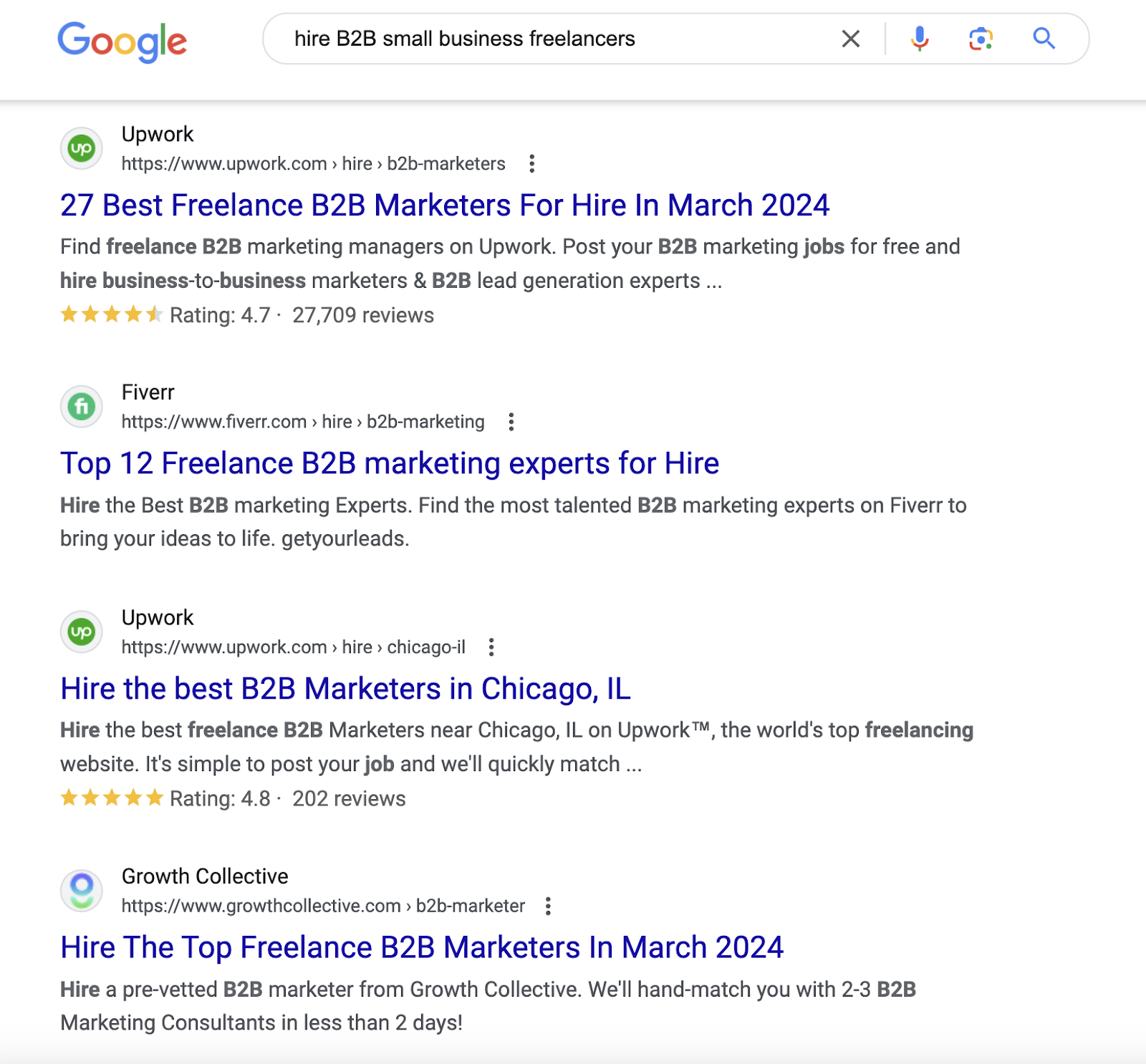
Benefits of Outsourcing Content Writing
- Cost-effective: Outsourcing content can be more cost-effective than hiring full-time, in-house writers because you only pay for the content you need. Without additional overhead costs. Like salaries, benefits, and office space.
- Helps scale content production: Outsourcing allows you to easily scale your content production up or down based on your needs. Without hiring or managing an in-house team.
- Diverse range of talent: Working with a diverse team of writers from different backgrounds can bring fresh perspectives and insights to your content. Enhancing its quality. And appeal.
- Time savings: By delegating content writing tasks to external professionals, you free up time for your internal team to focus on core business activities
- Faster turnaround: With dedicated writers working on your content, you can expect faster turnaround times. Compared to handling everything in-house.
Should You Outsource Content or Keep It In-House?
Whether you outsource content or create it in-house depends on your needs.
| Criteria | Outsource Content | In-House Writers |
| Expertise | Lack of specialized knowledge or skills in-house | In-house team possesses the necessary expertise |
| Cost | Cost-effective compared to hiring full-time staff | Potential cost savings from using existing team |
| Quality Control | Ensuring consistent quality may be challenging | Direct oversight enables stringent quality control |
| Confidentiality | Sensitive information requires trustworthy partners and NDAs | Internal team helps ensure data security and confidentiality |
| Time Constraints | Tight deadlines require quick turnaround | Flexibility to manage timelines internally |
| Control | Relinquishing some control over content creation | Full control over content strategy and execution |
| Scalability | Easily scale production up or down as needed | Limited by internal resources and capacity |
How to Outsource Content Writing
Follow these steps to successfully outsource content writing for your brand.
1. Identify Your Goals
First, determine why you want to outsource content writing. Setting goals for your content marketing strategy will help you identify the types of content you’ll need.
For example, if your goal is to boost organic traffic, you might outsource these content types:
- SEO blog posts
- Evergreen content
- Guest posts
- Social media posts
- Email newsletters
If you want to generate leads, you could outsource:
- Ebooks/white papers
- Press releases
- Product-focused blog posts
- Case studies
- Webinars
Defining your goals ahead of time will also help you source the right talent. And effectively communicate assignments.
Setting key performance indicators (KPIs) is important when outsourcing content writing. This can help ensure the work meets your expectations. And is contributing effectively to your business goals.
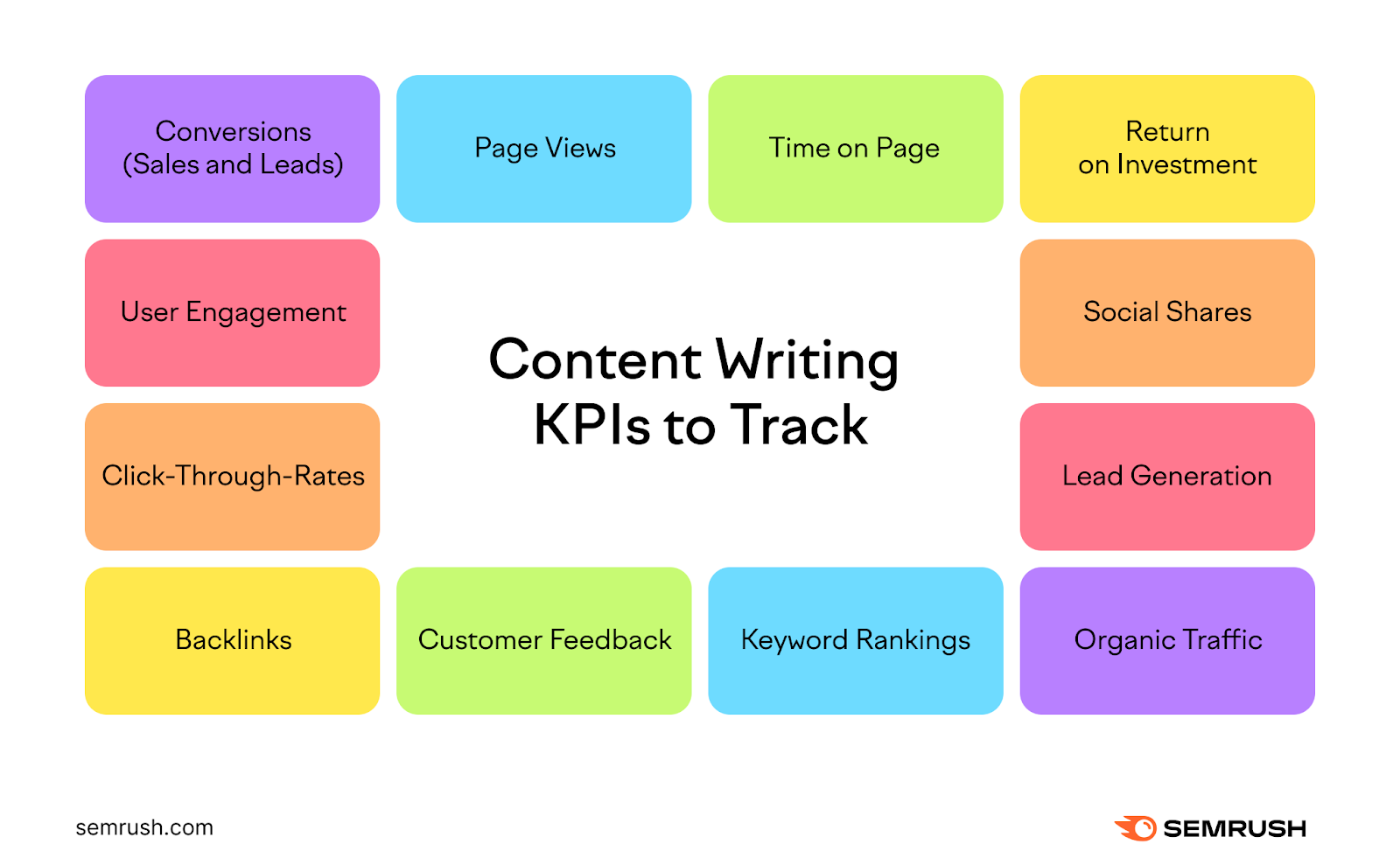
Consider these KPIs:
- Engagement metrics: Track page views, time on page, and social shares
- SEO performance: Monitor keyword rankings, organic traffic, and backlinks
- Conversion metrics: Measure conversion rate and lead generation
- Customer feedback: Gather feedback through surveys, comments, and reviews
- Cost metrics: Calculate cost per article and ROI
2. Determine the Type of Writer You Need
Writers come in all forms.
Including:
- SEO writers: These writers create content to help websites and blogs rank in the search engine results pages (SERP)
- Technical writers: Instructions, documents, how-to manuals, and frequently asked questions. For example, a technical writer might create a step-by-step guide for implementing software.
- Copywriters: Sales specialists who create ad, web, and social media copy. To generate leads. Awareness. And sales.
- User experience (UX) writers: Content that guides the user experience. For example, UX writers might write instructions and tooltips for a software funnel.
- Email marketing writers: Emails, promotions, announcements, and offers
- Social media writers:These writers specialize in capturing an audience through platform-specific trends and features. Like leveraging hashtags and relevant lingo.
- Thought leadership writers: Content based on a unique point of view. To build authority in your niche. Thought leadership pieces can be used for sales, engagement, promotion, or even SEO.
You’ll also want to consider skill level. Do you need an expert? Or is it a beginner-friendly topic that a newer writer can handle? This can affect your budget. As more experienced writers often charge more.
3. Select the Person Responsible for the Outsourcing Process
Outsourcing generally frees up the time of your in-house team. But that doesn’t mean it’s a set-it-and-forget-it solution.
Designate a lead for your outsourcing efforts. To handle these tasks:
- Content types and topics: Will you outsource blog posts, web copy, social media posts, or email marketing? What topics will you cover?
- Content briefs: Write briefs that outline what should and shouldn’t be included in the content
- Hire freelance talent: Post a job or source writers, vet talent, and manage the contracting process
- Manage communications: Oversee communications. From sending new assignments to answering questions about ongoing projects.
- Review/edit outsourced content: Review the quality of finished content. And request revisions if necessary.
- Develop processes and documentation: Write freelancer guidelines. And training materials.
These tasks may fall on different team members. Depending on the size of your content operations. Communicative, organized, and detail-oriented team members are vital to outsourcing success.
4. Budget for Content Outsourcing
Once you’ve established your goals and how to measure them, it’s time to set a budget.
Consider the following factors to determine an adequate budget:
- Will you use a content outsourcing platform that charges membership fees? Or commissions?
- Do you plan to pay by the word, the article, or the hour?
- Does the rate change based on the number of revisions?
- What level of experience do you want your freelancers to have?
- Do you need someone with specialized expertise? Note that this can affect your costs. For example, legal and medical writers may charge more.
Thirty-four percent of businesses spend $1,000 to $5,000 on outsourced content each month. According to Semrush’s State of Content Ops and Outsourcing Report.
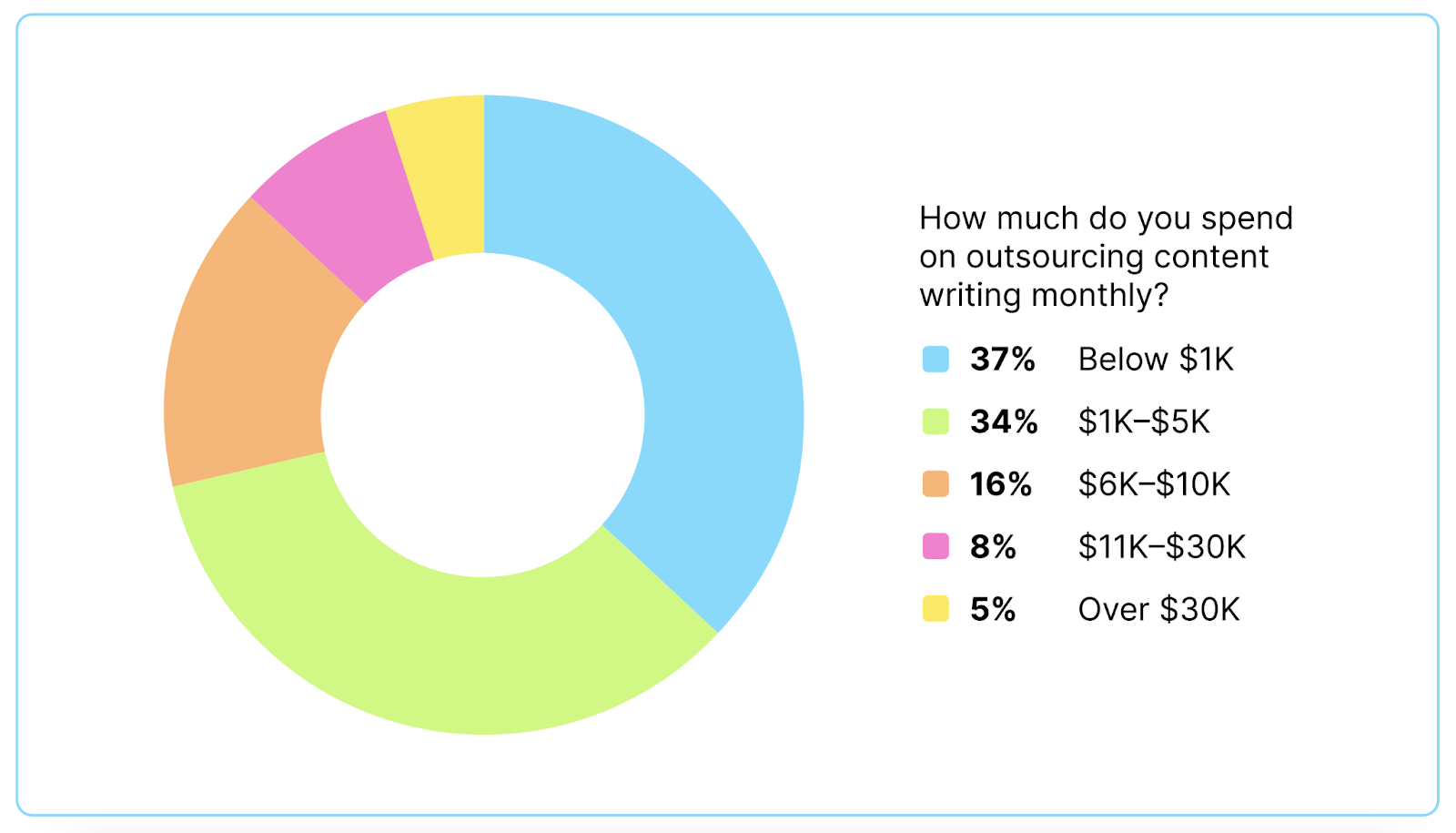
Your budget will depend on the type of content you need. Writer expertise. And niche.
Here’s an idea of what different freelance writers charge, according to Upwork:
- Technical writer: $20-$45 per hour
- Social media writer: $25-$40 per hour
- Content writer: $15-$40 per hour
- Copywriter: $19-$45 per hour
- SEO writer: $15-$35 per hour
- Grant writer: $35-65 per hour
- Blog writer: $15-35 per hour
5. Choose the Right Content Outsourcing Partner
There are different ways to outsource content writing.
Options include:
Freelancers
This is one of the most common methods of outsourcing writing tasks. There are a number of freelancing platforms (more on that later) where you can find talented writers.
But you also can reach out to freelancers directly. On sites like LinkedIn.
Here’s how:
Search “freelancer,” “freelance writer,” or “freelance + [niche]” on LinkedIn to find potential candidates.
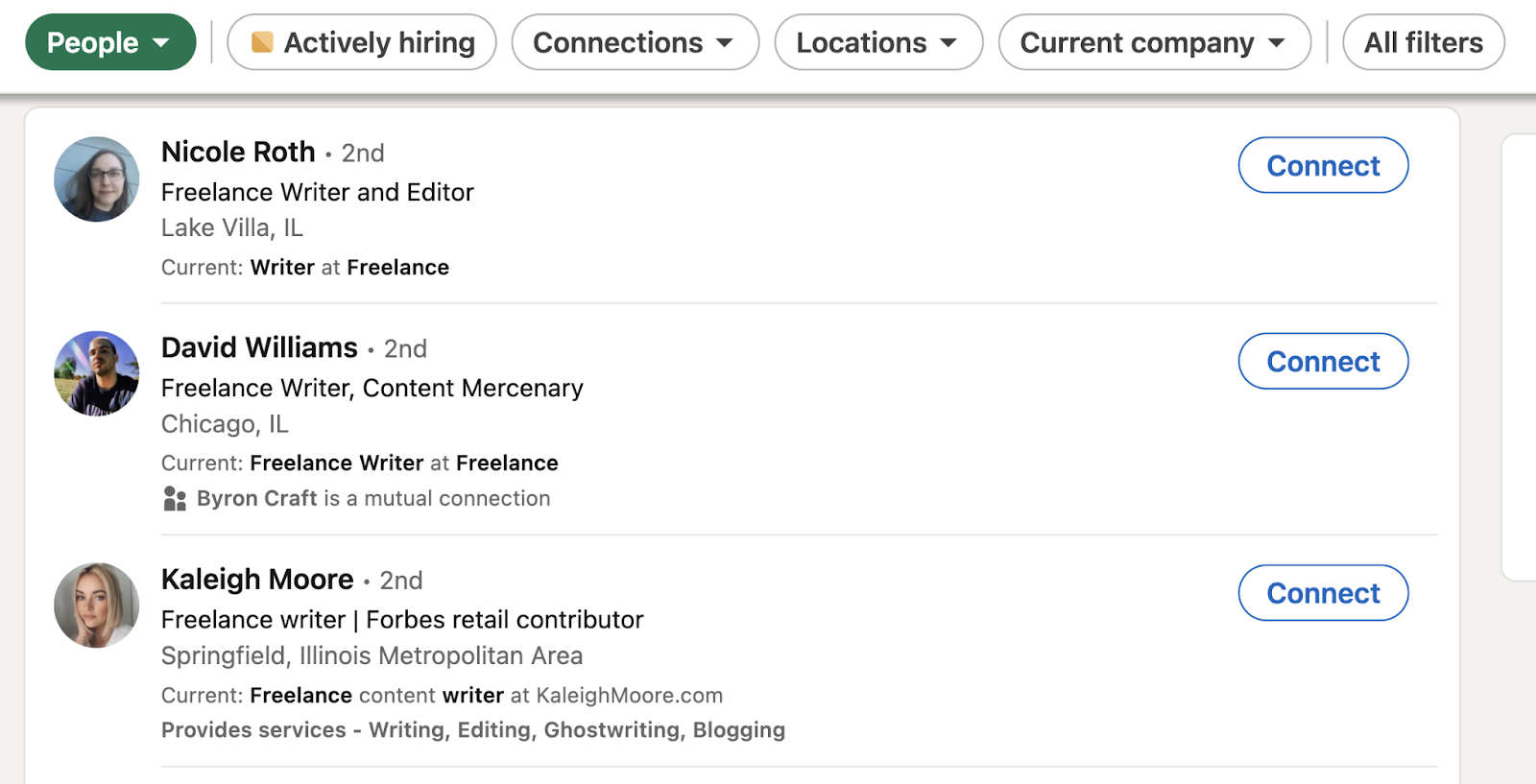
Alternatively, post ads for freelance writing jobs on popular boards like:
Hiring freelancers is a good option for companies of all sizes. It allows you to negotiate contracts and rates with freelancers directly.
Agencies
Content marketing agencies offer extensive content marketing solutions.
If you have the budget but lack the internal team, a content agency can take ownership of your content marketing efforts.
Content marketing agencies can often handle all aspects of content creation.
Including:
- Content strategy
- Outlines
- Content briefs
- Writing
- Editing
- Writer management
- Performance tracking
Many agencies can act as a third-party marketing team if needed. Others may only offer writing services. Determine your needs and find an agency to match.
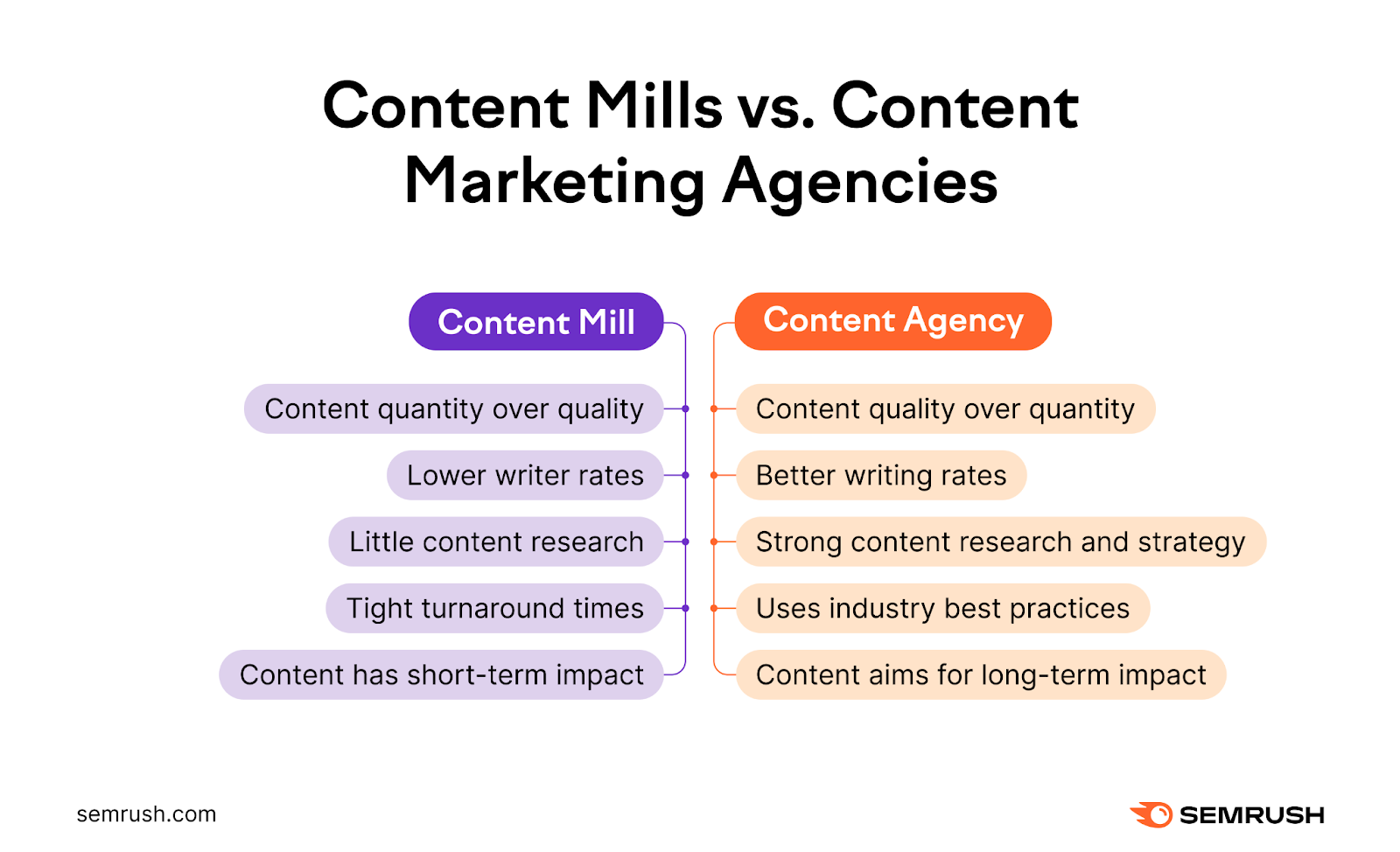
Content Mills
Content mills, also called content farms, focus on quantity over quality. These platforms employ freelancers to produce mass quantities of content. If you need a large amount of non-specialized content, this is an affordable approach.
The downside is that you usually can’t handpick your freelancers. Or find writers with niche expertise.
Because content mills tend to be more affordable, the writers are also usually paid less. This means many freelance writers are just starting their careers when they work for content mills.
All of this generally means you get less experienced and less specialized writers.
Niche Experts
If expertise is what you’re after, focus on finding niche experts. This can help you produce high-quality content written by industry specialists.
But you’ll need to budget accordingly.
According to the Editorial Freelancers Association, medical freelance writers make $82.50 to $110.00 per hour. While non-specialized, work-for-hire writers make $50 to $79 per hour.
If you can commit the time and money, finding an expert writer can positively impact your content beyond how well it’s researched.
It can also help you demonstrate E-E-A-T (Experience, Expertise, Authoritativeness, and Trustworthiness). Which is part of Google’s framework for assessing content quality. (Not a part of its algorithms, but an essential directive given to human search quality evaluators who work for Google.)
This is especially important for “Your Money or Your Life” (YMYL) topics. Like finance, medical, and health-related topics.
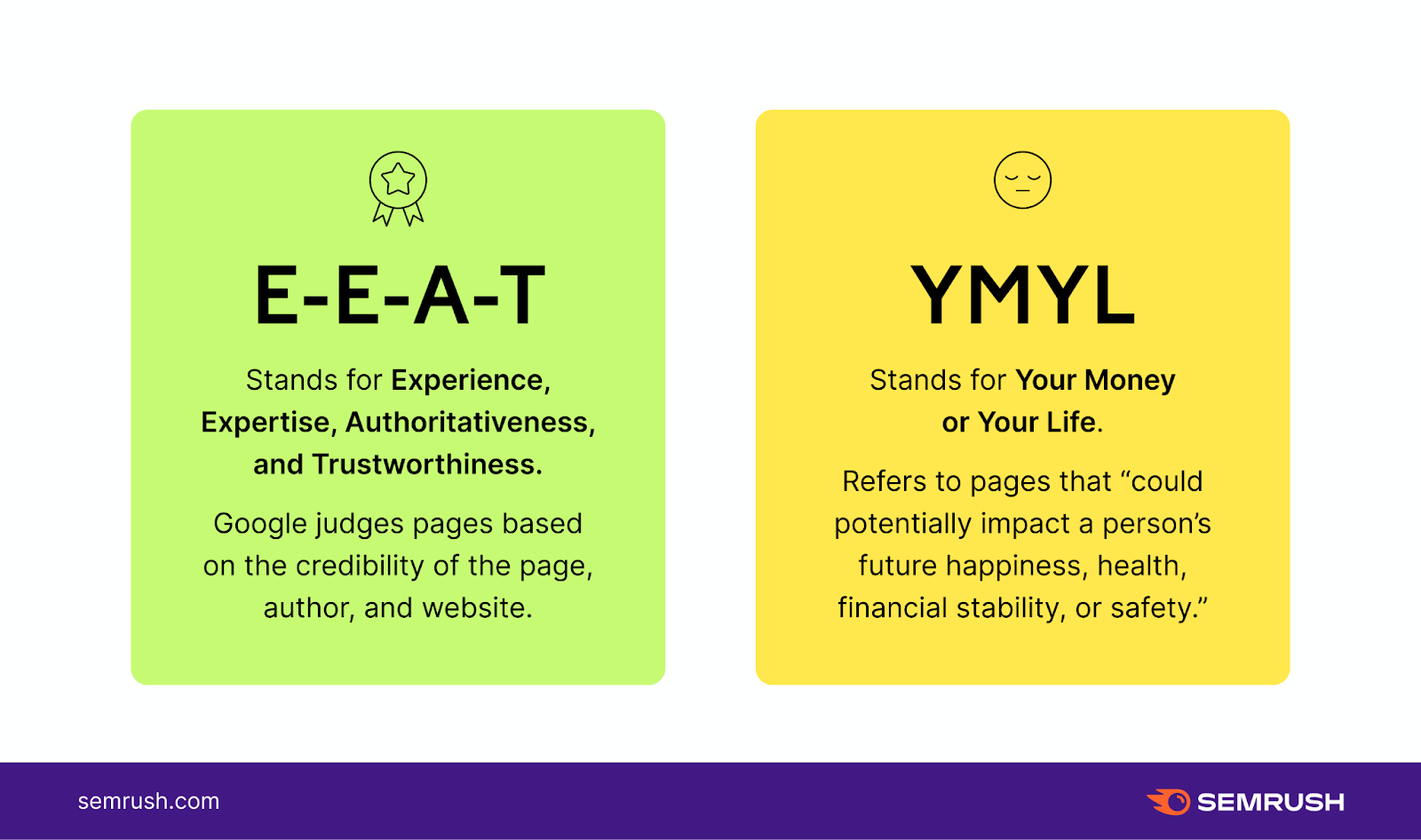
If you publish YMYL topics, it could be worth budgeting more for highly experienced writers.
6. Vet Writers with Test Assignments
Whether you require a test assignment is up to you. The writer may have enough relevant examples in their portfolio that you feel confident hiring them on the spot.
In some cases, it may still be helpful to ask writers to complete a writing test. Before hiring them for a project.
Keep the test short. And consider compensating writers for the work. This can help increase the quality of candidates you receive.
The test should measure the freelancer’s writing abilities. Like grammar, spelling, and logical flow. And also reflect your content needs.
For example:
- If you’re looking for niche expertise, ask them to incorporate industry knowledge into a test article
- If you’re looking for an SEO writer, ask them to incorporate keywords into a test article and format anchor text
Provide specific instructions. Like word count, keywords, brand voice, subjects to address, and links to include. This will help you gauge how well they follow direction. And if they’re a fit for your brand.
7. Establish Communication and Workflow
Establish your outsourcing workflow early in the process. So your outsourcing lead and your freelancers have a smooth system in place.
- Create a content calendar: Your content calendar should outline all your upcoming content. And designate what should be outsourced.
- Establish your communication flow: This includes deciding which team member manages freelancer communications. And setting a cadence for those communications.
- Set deadlines: Set deadlines for drafts and revisions. And make them clear to your outsourcing partner. Depending on the scope of the content, deadlines may be anywhere from one week to one month.
- Define your invoicing process: Ensure freelancers know when and how to submit invoices. And when those invoices will be paid.
Ideally, these processes will be clearly outlined in your contracts.
8. Consider Legal and Contractual Matters
To protect your company and respect your freelance talent, draw up a contract. And make sure someone with legal expertise and credentials reviews it.
Generally, an outsourced writing contract should include:
- Description of services: What type of content they’ll write. And what website they’ll write for.
- Expectations: Production expectations. Like the number of articles required. And word count.
- Payment terms: Rates, how often they’ll be paid, and when and how you’ll send payments
- Rights: Who has ownership rights over the content
- Attribution details: Whether the writer will have an author byline on content they produce. And what information that byline will include. Like whether they can link to their own website in their byline.
- Terms and conditions: Confidentiality agreement, non-disclosure agreements, non-compete terms, contract termination terms, and other applicable terms and conditions
To ensure you include the right terms and clauses, consult your legal team or use an online contract service.
Once your contract is set, get signatures from relevant parties before you begin outsourcing work.
9. Generate Topic Ideas
Whether you hire freelancers or a content agency, you or someone on your team will likely need to provide the content ideas.
To identify content ideas, use Semrush’s Topic Research tool.
Open the tool, enter a topic idea, and click “Get content ideas.”
For this example, let’s say you need content for a pet grooming website.
The tool will generate various ideas related to pet grooming.
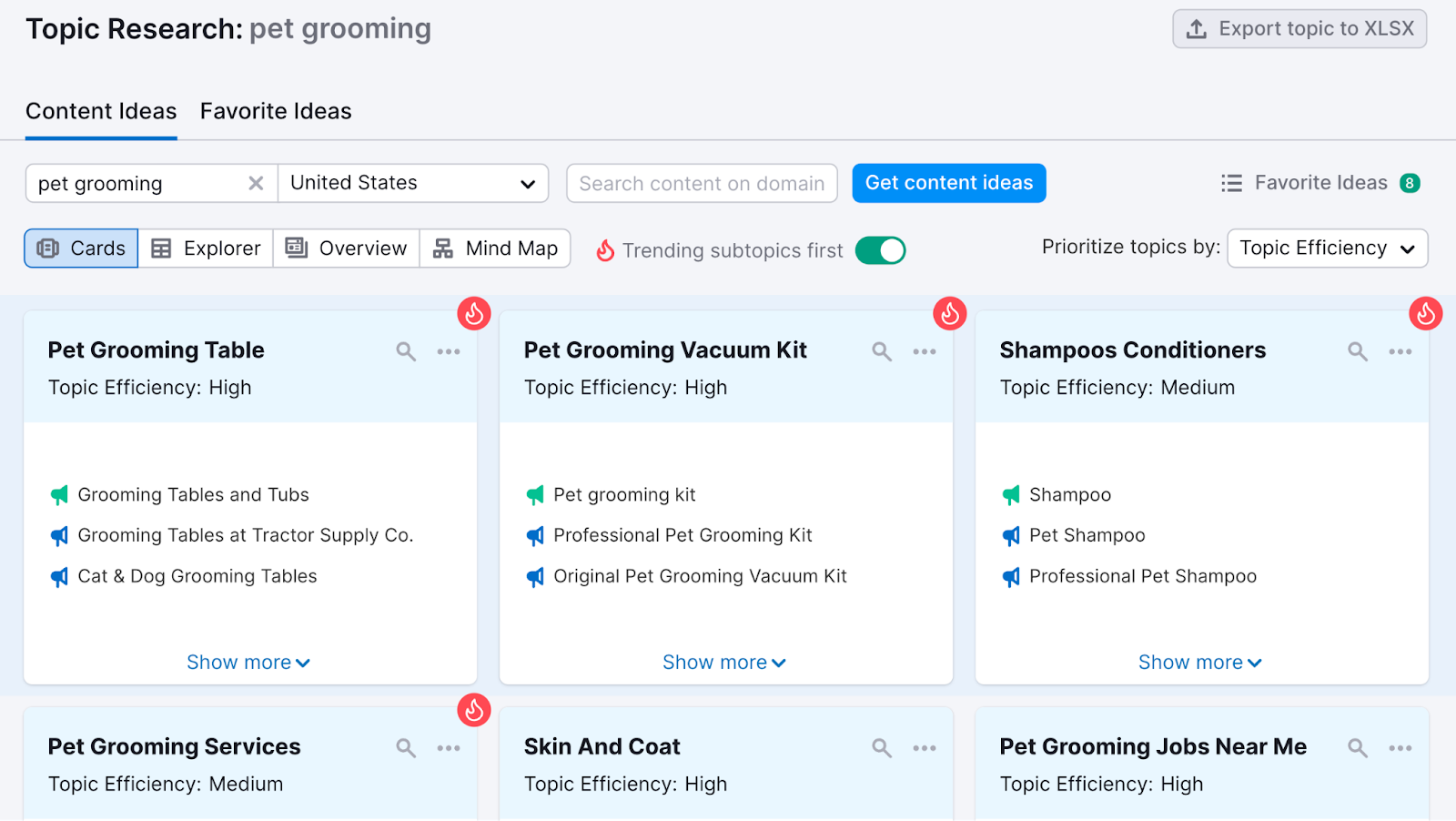
Click on an idea to see more details. Including “Subtopic Volume.” This is the keyword search volume—the estimated number of Google users searching this term each month.
Higher Subtopic Volume indicates more interest in that topic.
Build out your content calendar using the ideas you generate with Topic Research. To ensure you cover all relevant topics. And then assign them to writers. Based on expertise.
10. Create a Detailed Content Brief
A content brief is a document that communicates expectations to the freelancer.
Content briefs should include the following:
- The goal of the content: The goal of the content may be to teach the audience about a topic. Or sell a product. Include this information in your brief. So the freelance writer can use the appropriate tone of voice. And include the necessary information.
- What keywords you’re targeting: Include your primary keyword. And secondary keywords if applicable. Use the Keyword Magic Tool to identify what keywords you should target.
- What stage of the funnel you’re trying to reach: Is the aim of this specific page to bring in new customers? Upsell customers engaged in the buying process? Or appeal to your established base of customers?
- Brand voice: Link to your style guide. And any other relevant documentation that can guide a freelancer on adhering to brand voice.
- Links, statistics, or products: Include specific information. Like internal links, external links, products, or study findings. That you want the writer to include.
- Your competition: List competing websites or brands the writer should avoid linking to in the content. And include competitor links to top ranking articles for the same topic.
- Approved sources: Include sources the writer should link to. Like government or educational websites. Or certain subject-matter authorities within your niche.
- Examples of relevant content: Provide examples of relevant content on your site or related sites that the writer should emulate
- Visuals you want the writer to include: Mention any images, whether they’re in-house infographics or images from an external source, the writer should include in their work.
11. Implement Quality Control and Feedback Mechanisms
Review outsourced content to ensure it matches your style guide, quality standards, and goals.
This can be done by an in-house editor. Or outsourced to an editing partner. Or freelance editor.
Use third-party content editing tools to assess SEO potential and grammar.
For example, use Semrush’s SEO Writing Assistant to analyze drafts for readability, SEO, originality, and tone of voice.
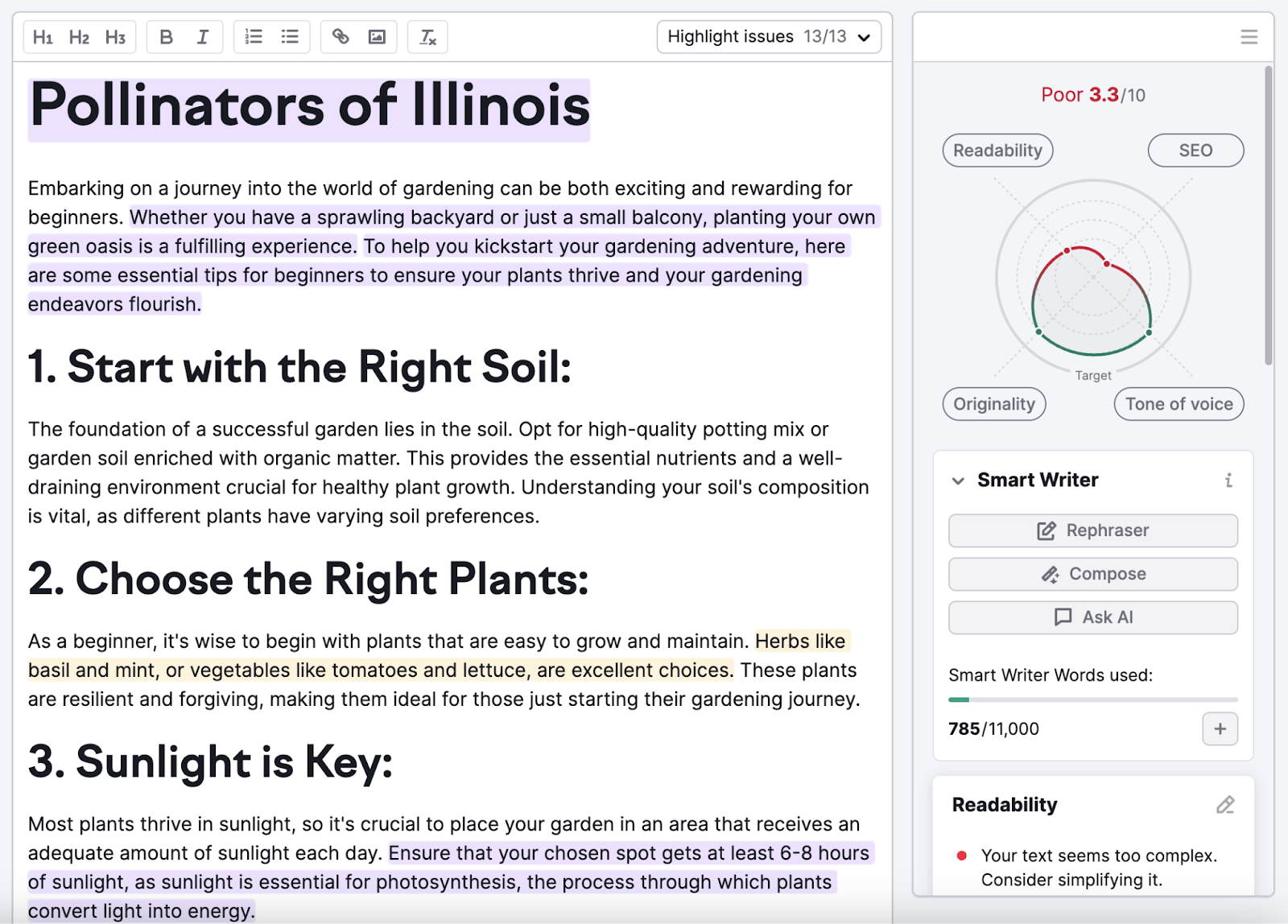
And use tools like Grammarly to quickly review a freelancer’s writing mechanics. Many of these tools offer free browser plugins. So you can easily run a review on a Google Doc to catch grammar and spelling mistakes.
If the content is on a niche subject, consider having an expert review it for accuracy. If your article is product or industry-specific, ask a relevant team member to review it.
This can help keep quality high. No matter who writes your content.
Request Revisions
Follow these best practices to get the most out of revision requests:
- Clearly state revision requirements while hiring. Including how many rounds of revisions you require.
- Get feedback from relevant team members before sending revision requests to the writer
- Be mindful of word count. For example, if you ask the writer to add another section, it may increase the word count enough that you need to pay more. Depending on your contract’s payment terms.
- Be specific with your feedback
- Give examples of what you are looking for
- Provide actionable tips. To help the writer provide the desired result.
Incorporate Feedback
The best way to produce quality outsourced work is to tell your freelancers what is and isn’t working.
Incorporate feedback into your revision requests that explain any issues. And how the writer should approach them the next time.
Compliment what they’re doing well. So they know to keep doing it.
If you’re noticing frequent problems with the quality of content you’re receiving, try
- Creating training materials for freelancers to work through before they start their first assignment
- Revisiting freelancer guidelines to ensure they adequately detail expectations
- Revising content briefs for thoroughness
- Switching freelancer platforms or outsourcing services
- Improving your freelancer vetting system
- Offering incentives for high-quality work
12. Track Your Content's Success
Once your content is published, start tracking results.
Use Google Analytics to monitor traffic and engagement.
Look at data like:
- Search traffic
- Conversions
- Time on page
- Click-through-rate (CTR)
- Bounce rate
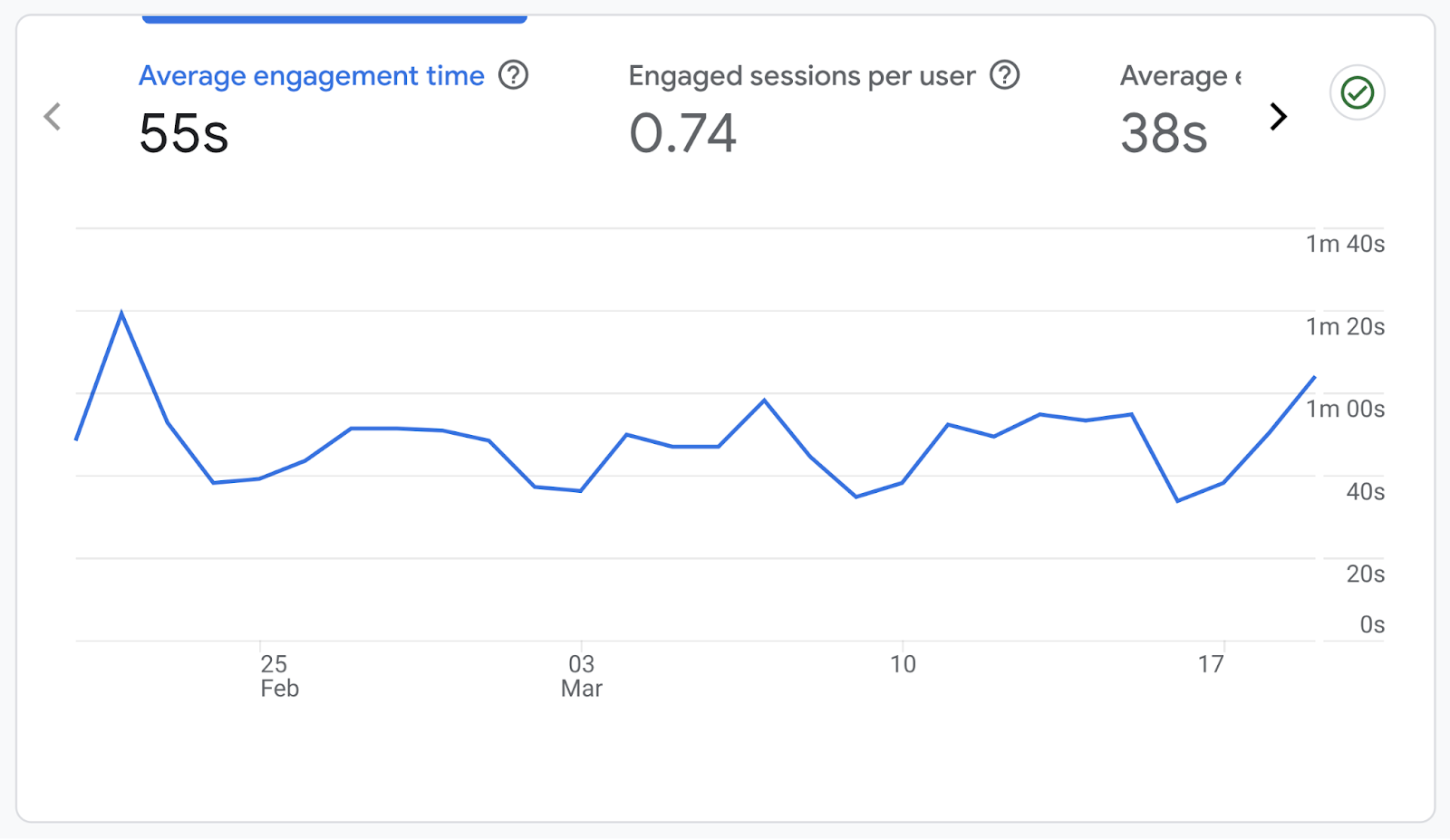
Analyze your top-performing content. To help you and your freelance team optimize the writing process moving forward.
Platforms for Outsourcing Content Writing
Here are some popular platforms where you can source freelance writers:
Upwork

Best for: Individuals or teams with limited budgets
Upwork offers a wide range of talent. Including creative writers. Podcast writers. And even speech writers. Select the category you’re interested in based on your needs. Like grant writing. Or a blog post writer. And view writers’ portfolios. And rates.
If you find a writer you want to work with, select the service package you want (if applicable). And pay for their services.
Alternatively, post a job ad with your own rates. And project details. Upwork writers can apply to your job. And you’ll pay them through the platform.
The large talent pool means you need to post a competitive job to get attention from top writers.
Fiverr
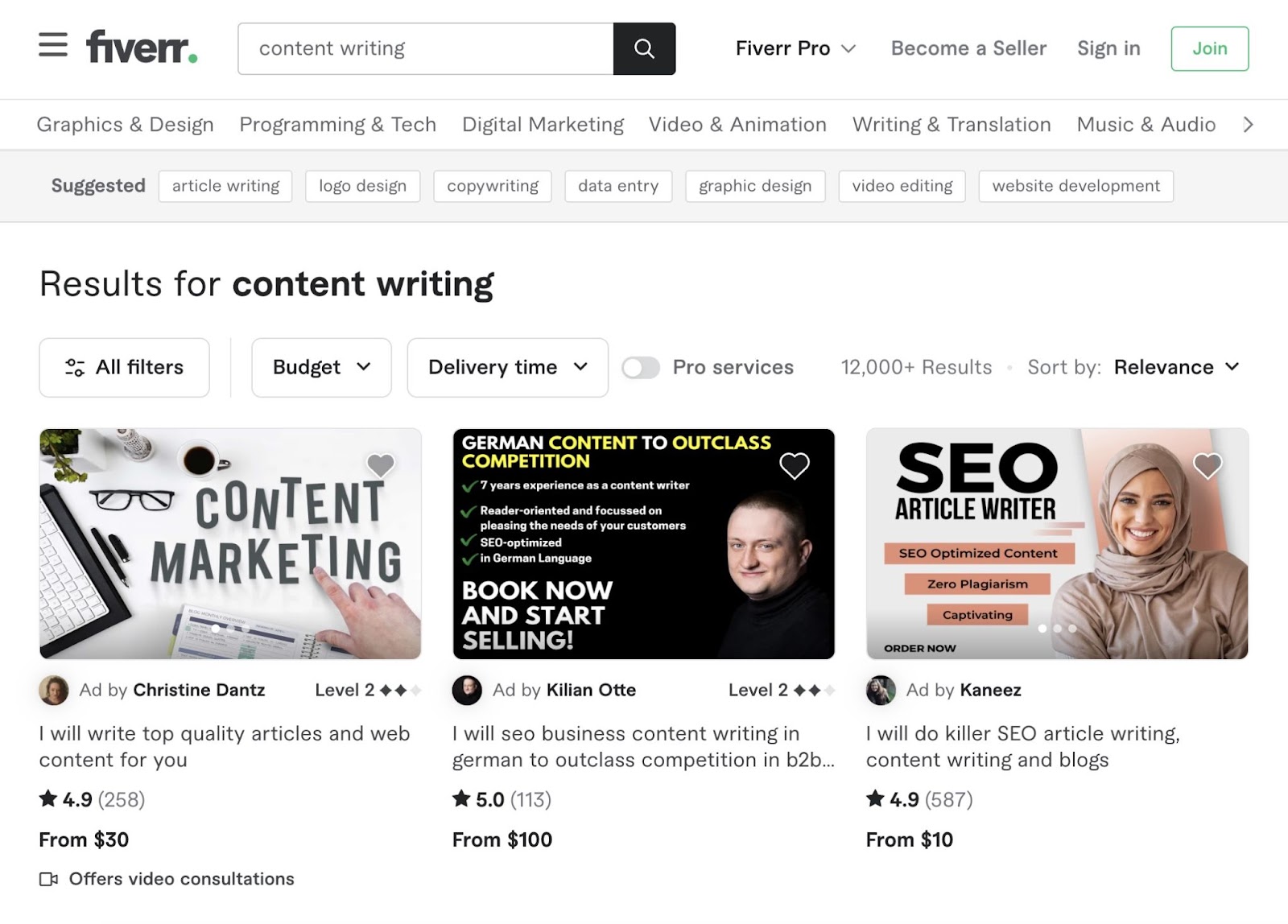
Best for: Individuals and teams with limited budgets
Fiverr is a freelance marketplace that lets you post jobs that freelancers can bid on.
Or you can seek out talent on the platform.
Fiverr is not a writing-specific platform. It’s a gig platform that connects freelancers from a wide range of industries with buyers. This means you may need to look harder for the service provider you want.
Contently

Best for: B2B and B2C websites with large content needs and high budgets
Contently is a cloud-based content agency that specializes in B2B and B2C content. In exchange for a subscription fee, Contently will manage your outsourced content.
The platform is a good option for teams who want to outsource the entire content creation process. As Contently helps manage everything. From content strategy development to writing.
Contently vets its content writers and provides helpful resources. Including training, webinars, documentation, and live support. This helps ensure high-quality results.
Its subscription fees are unique to a company’s needs. Request a quote to get pricing.
WriterAccess

Best for: Individuals and businesses of all sizes with varying budgets
WriterAccess is a freelancer platform that charges monthly subscription fees.
The platform helps manage your content outsourcing workflow. And offers different tools for different subscriptions. All subscription levels have access to the WriterAccess writer marketplace. Including a selection of AI writing tools and image sourcing.
There are two subscription models:
- Platform: You pay a monthly subscription fee to use the WriterAccess platform. Then purchase content separately. There are four subscription levels that vary by approval time, workflow tools, integrations, and extras.
- Managed services: If you want WriterAccess to manage your content creation process, choose this service. This includes writer selection, talent management, platform integrations, image curation, and more.
These are just a few of the biggest platforms available for outsourcing content writing. The best fit for you will depend on the type of talent you’re looking for. And your budget.
Maximize the Benefits of Content Outsourcing
A successful content outsourcing strategy requires ongoing planning, action, and maintenance. Especially if you’re managing a team of freelance writers.
Speed up the process with Topic Research. And use Keyword Magic Tool to identify target keywords. This will help ensure you get high-quality, high-ranking content. Every time.
This post was updated in 2024. Excerpts from the original article by Maria Raybould may remain.
